▒▒▒▒▒▒▒▒▒▒▒▒▒▒▒▒▒▒▒▒▒▒▒▒▒▒▒▒▒▒▒▒▒▒▒▒▒▒▒▒▒▒▒▒▒ This number has been curated by Karolina Lukasik, Heta Lähdesmäki, and Toumas Aivelo from the Urban Rats Project. This issue was co-produced with Artem Pankin. ▒▒▒▒▒▒▒▒▒▒▒▒▒▒▒▒▒▒▒▒▒▒▒▒▒▒▒▒▒▒▒▒▒▒▒▒▒
Cite this article: Orrego, S. and Pankin, A. 2024. “Rats as urban infrastructures: A tale from two cities.” Tarde 4 (Mar-Apr). DOI: 10.17605/OSF.IO/Y762A
- Introduction to the issue
- Creating rats, the origin of urban evils
- Rats and the consolidation of the modern city
- Watching rats, a set of visual experiments
- Some pictures from New York
- A Watching Rats alphabet
- Online references
- Handbook references (Medellín)
- Handbook references (New York City)
Introduction to the issue
The conception of cities as multispecies scenarios of cohabitation [1] and confrontation [2] proposes two concatenated set-ups where, first, nonhumans living in urban areas are involved in different anthropocentric networks, most of the time frame in asymmetrical relationships of power [3]. Second, nonhumans are conceived not only as individuals living in human-made urban environments, but they are perceived as urban-makers. That perspective distributes the agency of urban production through a plethora of individuals who are constantly producing —in their own ways— new versions of the city space.
This issue of Tarde brings together the ongoing explorations of two rat viewers, one out of curiosity and the other as an attempt to overcome his phobia toward those animals. The explorations were carried out in two separate places: New York City and Medellín, Colombia. Our printed version (download it here) compiles a set of vignettes and reflections on rats producing and interacting with the urban space in both cities. Meanwhile, this is divided into two sections. The first one introduces a brief story of how rats turned into villains. The second one presents a set of infographics displaying some of our observations and different human-rat encounters spotted in both scenarios.
Creating rats, the origin of urban evils
The representation of animals as villains has been a constant activity in human history—the main reason for framing certain animals as enemies was their predatory behavior. However, the nineteenth century was the decisive point when animals started to be formally accused of acting as “reservoirs and spreaders of diseases affecting humans” [4].This technical and bacteriological labeling process was quickly enhanced and complicated by the irruption of an already solidified popular concept that originated in the mid-seventeenth century: vermin.
Vermin are “icky, dirty, nasty, disease-bearing animals who are out of place, invaders of human territory. Vermin are animals whom it is largely acceptable to kill” [5]. Those creatures have four main characteristics. First, they consume and contaminate human food sources and production. Second, they are smart. Vermin often finds ways to escape human attempts to catch and control them. Third, they “possessed the ability to manipulate symbols, and even language itself” [6]. Finally, vermin can quickly reproduce and establish large numbers of individuals, threatening to “overwhelm their biological, environmental, and—from a human perspective—sociolegal contexts” [7].
Although the meaning of villains and undesirable animals has remained unchanged, in modern political, hygienist, and animal-control discourses, the term vermin has been replaced or, at least, interspersed with pests. However, and mainly talking about rats, to consider those animals as pests, as disgusting creatures, is just a part of an ontological trifurcation that is also situating them as “lovable (pets) […] and scientifically ‘neutral’ (laboratory animals)” [8]. The difference between evil, good, and neutral rats is a matter of relationships, space, quantity, and, of course, utility.

Rats and the consolidation of the modern city
One of the critical factors in the development and modernization of cities worldwide was the creation of sewage infrastructure. This new technological development “not only removed human waste, it also helped rat populations disappear from view, affording them a new underground home that came to be seen as their natural habitat” [9].
According to Birgitta Edelman [10], disgust, among other things, was one of the main feelings that inspired the planning logic of modern cities. During the Victorian era, “disgust came to be associated with the lower parts of the body. The rejection and abhorrence of everything connected with bodily functions from the waist down was also […] reflected in the topography of cities where covered sewers were constructed to hide and dispose of the refuse.” So, in a clean and modern city, keeping the surface pristine and separated from the disgusting underground was a priority.
However, that is not what happens in Medellín or New York City. Although at different levels, both cities have severe issues managing and disposing of their trash. Plastic bags accumulate daily in the streets, unsupervised filthy containers, overflowed bins, and political lack of care and operation are the main reasons why the cities’ surfaces turn into attractive spaces for rats and other animals.
Watching rats, a set of visual experiments
The graphics below are part of two exercises exploring rats’s activities and human-rat interactions in New York City and Medellín, respectively. The first exercise was carried out in almost 40 urban spots in New York’s Upper West Side between January 2nd and 11th, 2024. The second one occurred in 2022 in two different locations in Calasanz, a neighborhood located in East Medellín. Those observations were made from October 4th to 18th and focused on two groups of rats and their encounters and collisions with people.
New York City
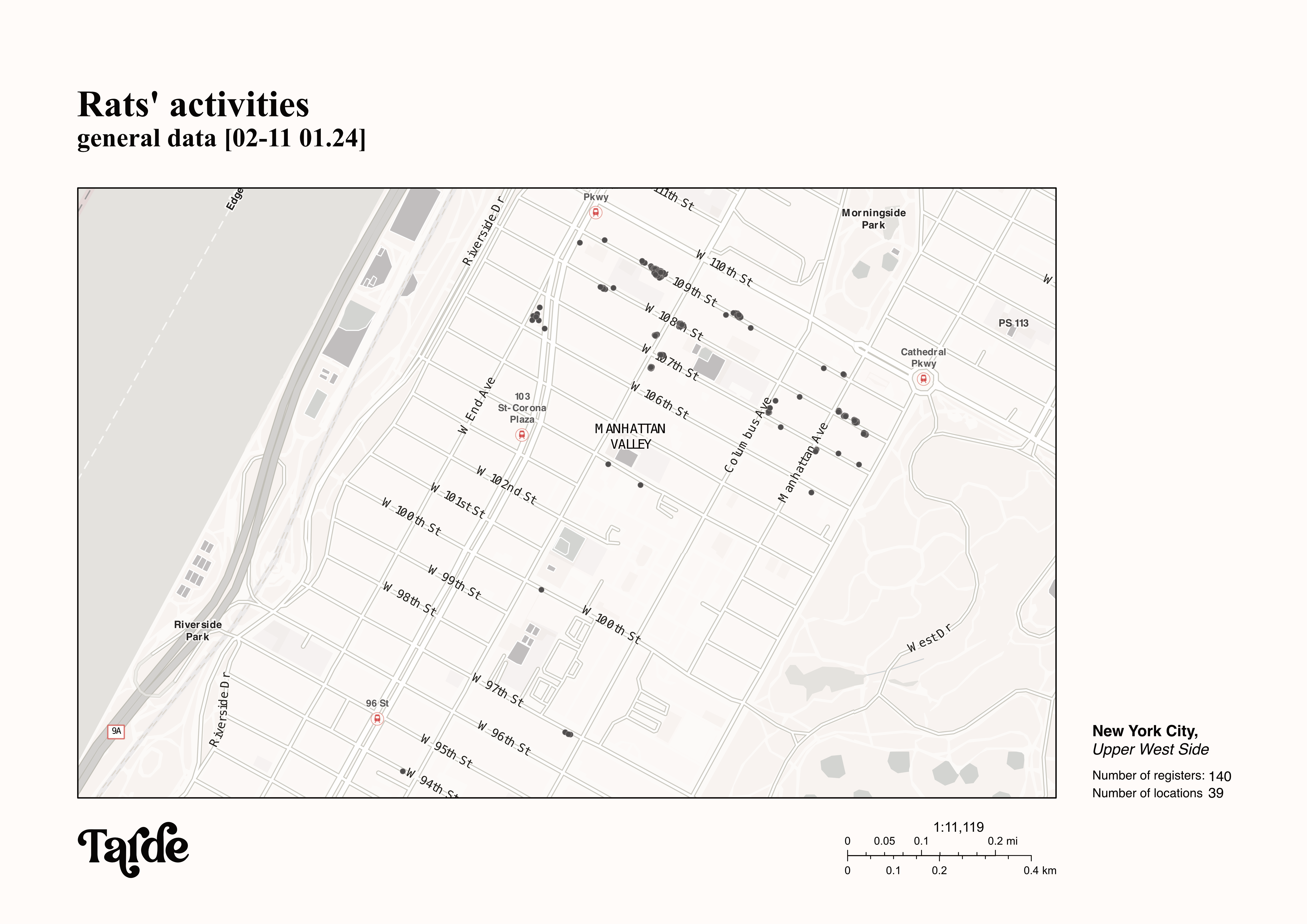
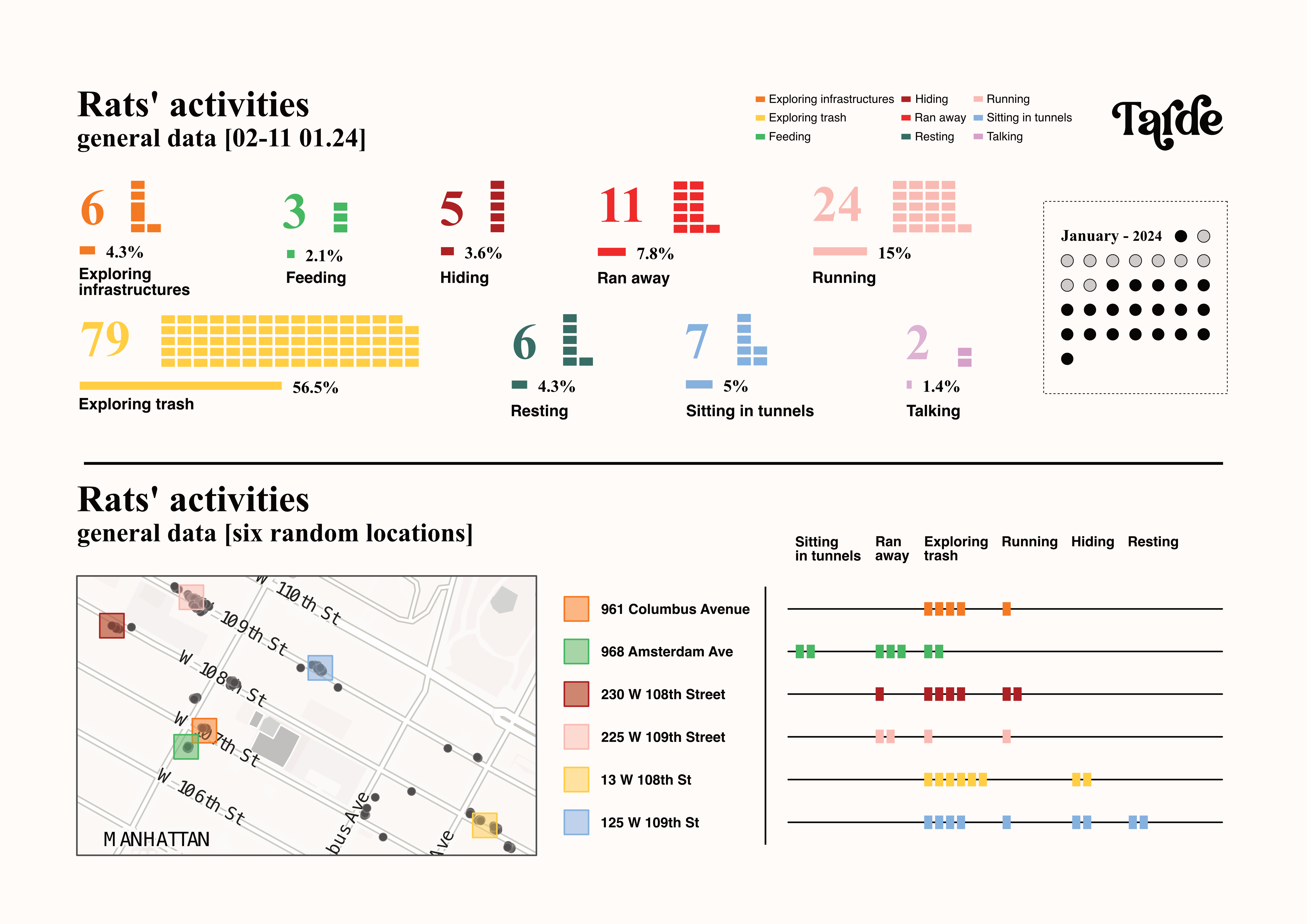
The upper part of this graph disseminates all the activities made by the rats around the different spots, and over the ten days, this exercise lasted. The bottom side takes six random locations and relates the number of rats observed with the activities they were doing.
Medellín

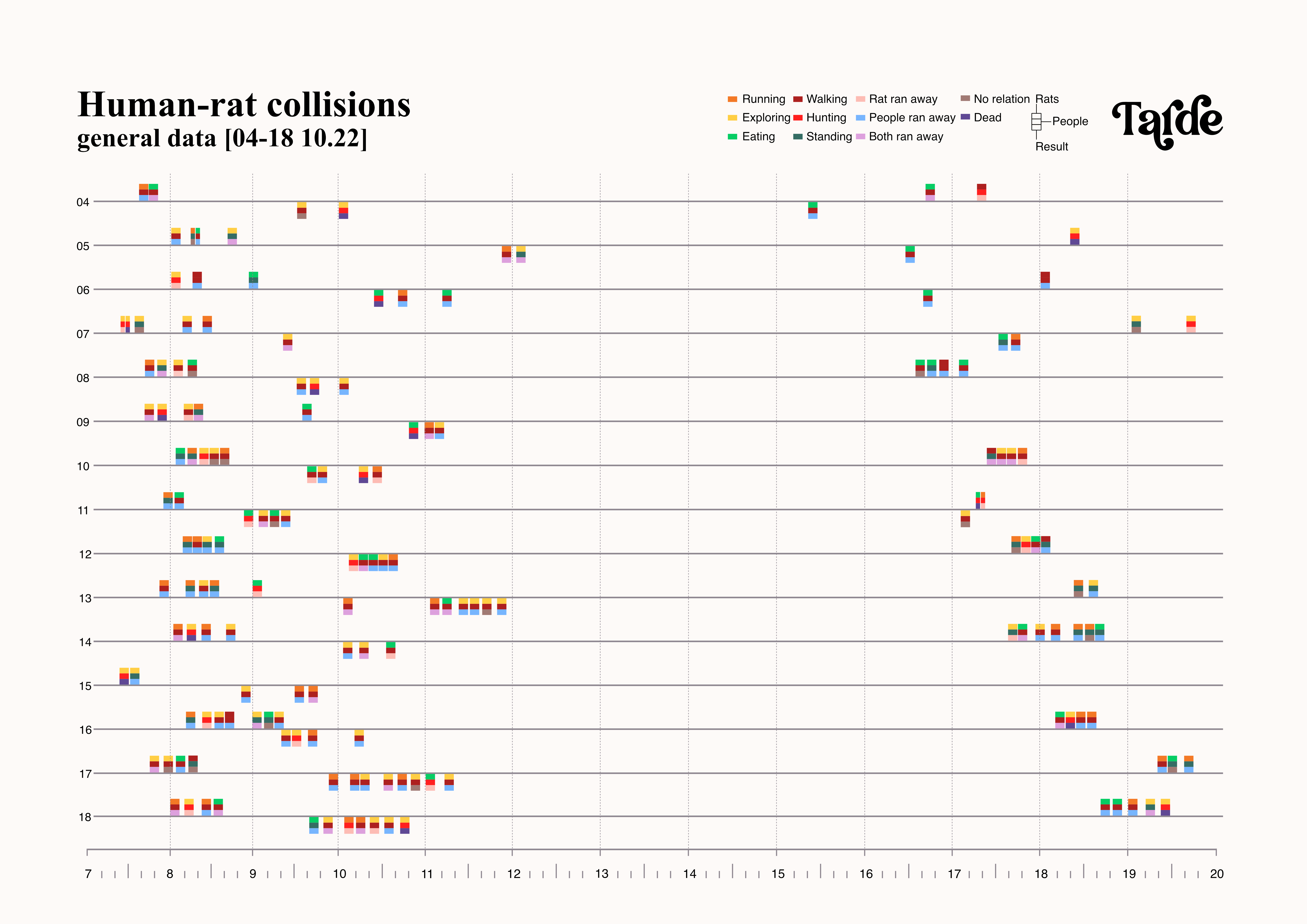
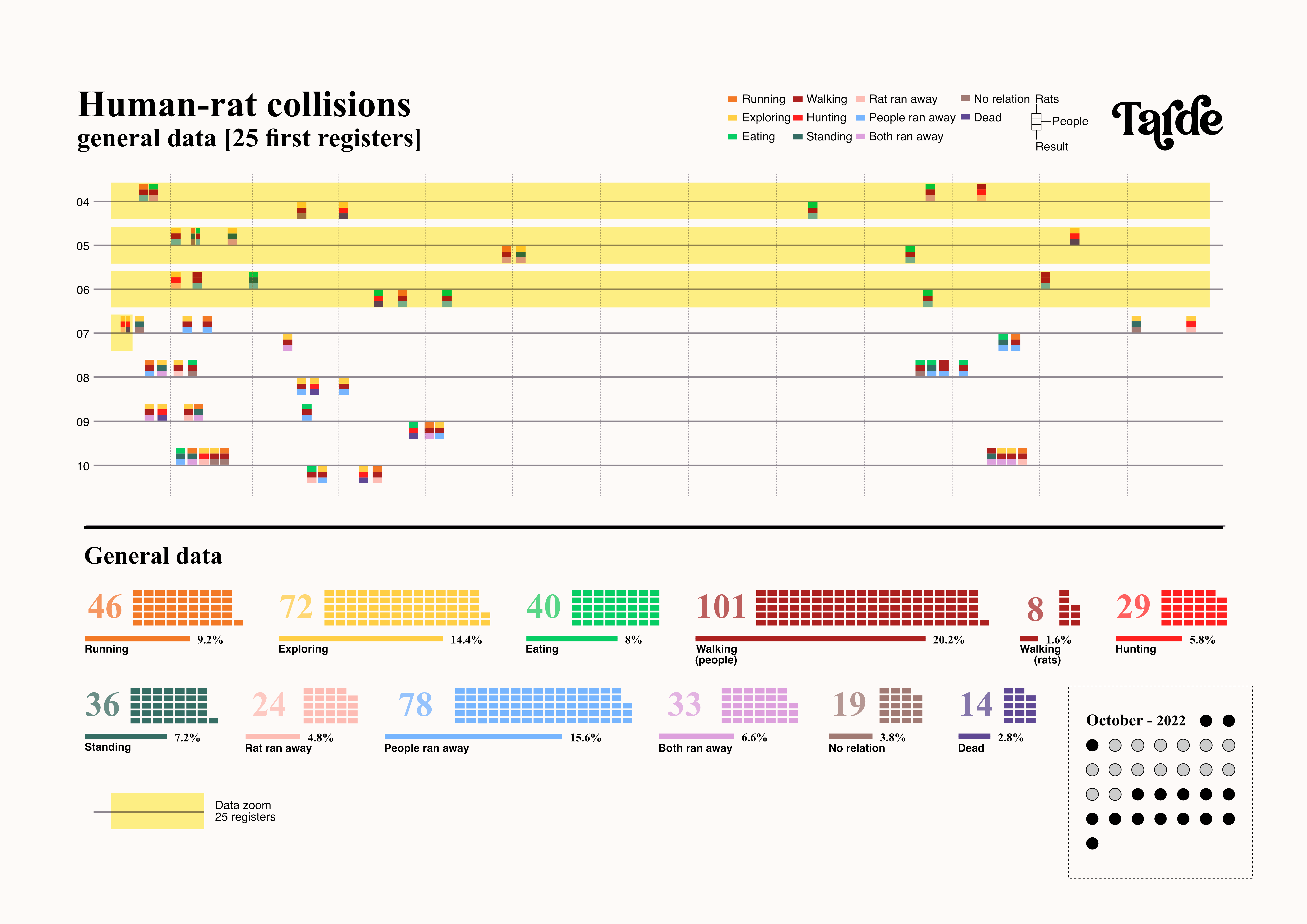

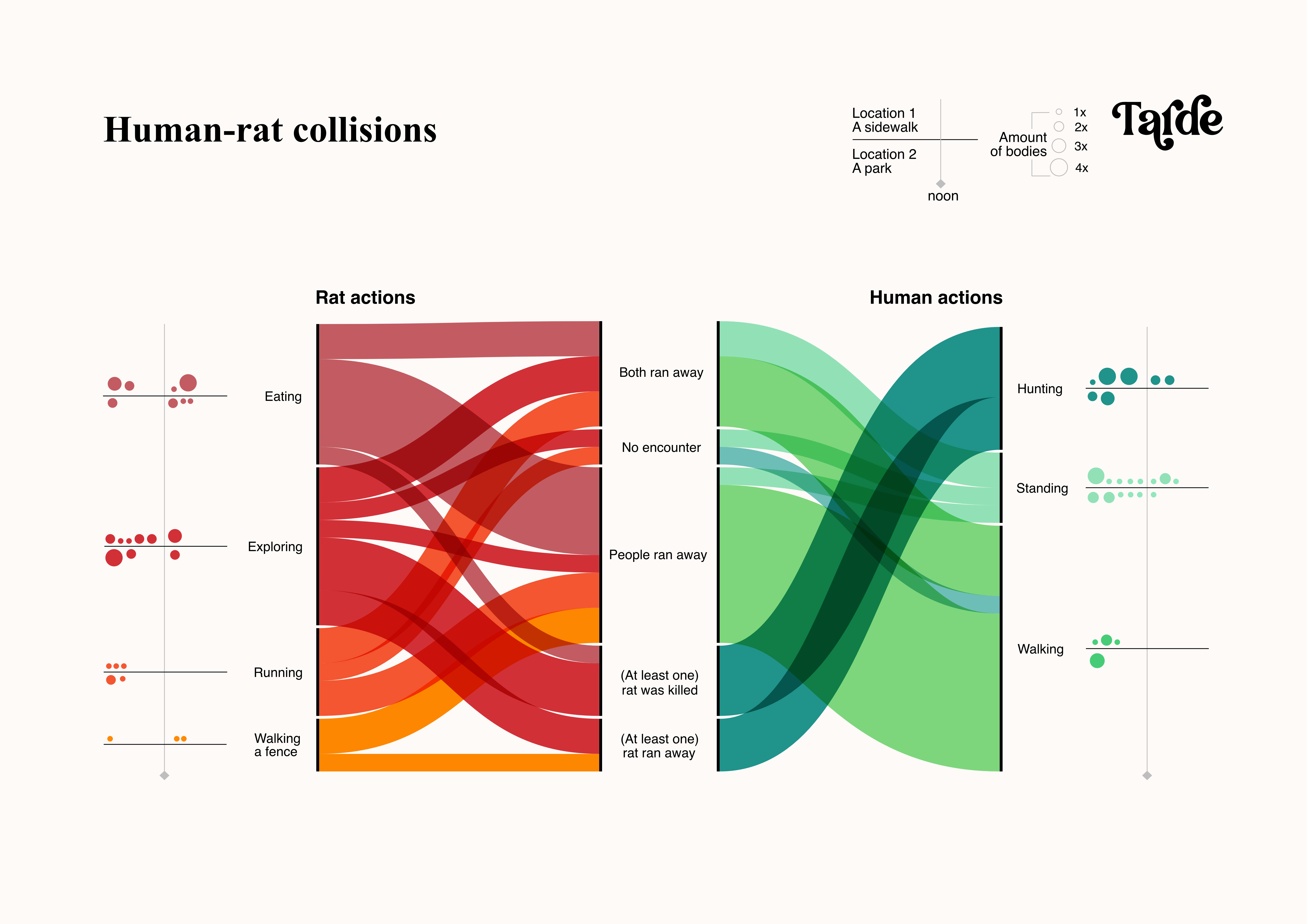
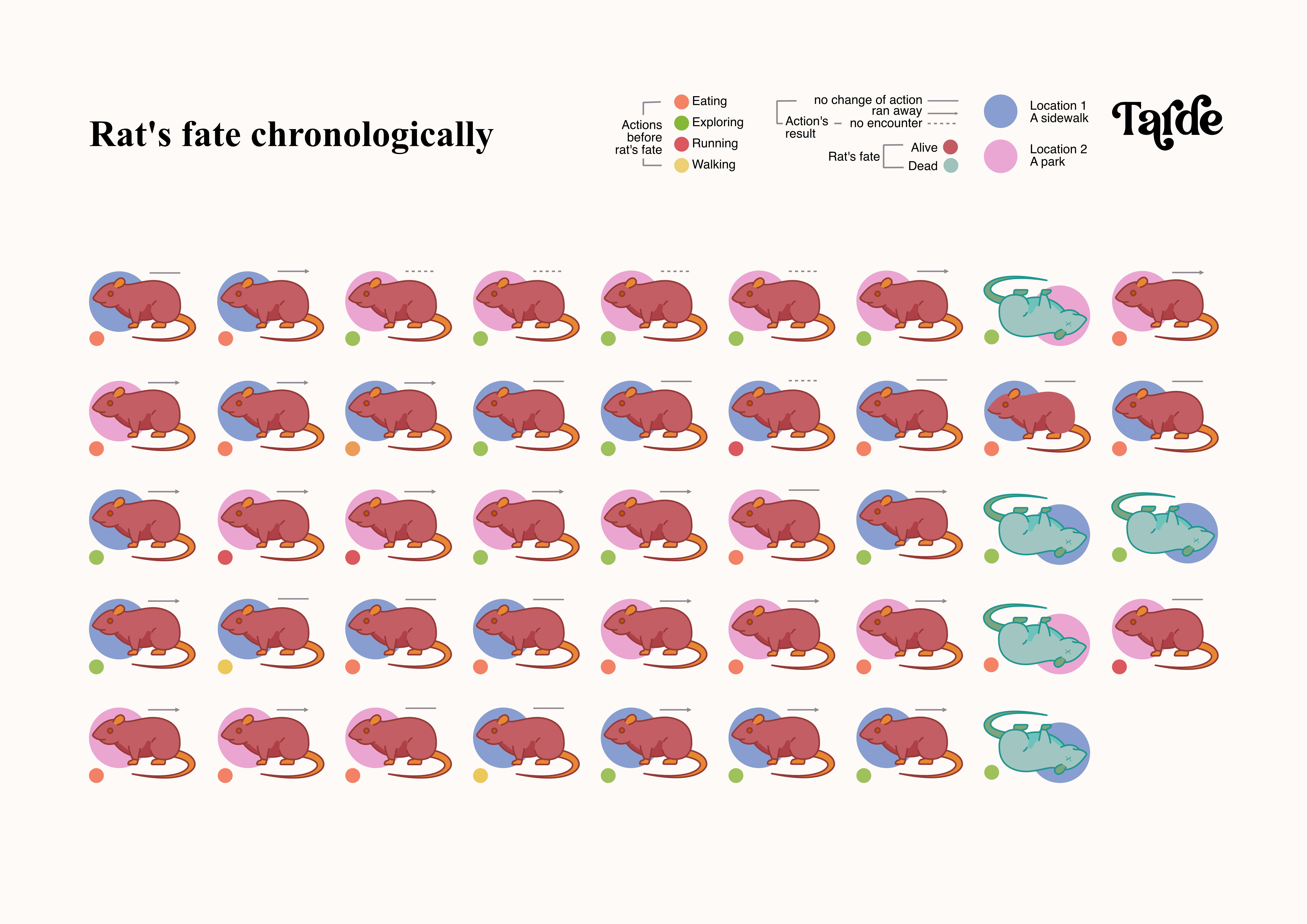
Some pictures from New York
The pictures of this gallery were taken during the exercise of document rats’ activities and infrastructures around the Upper West Side. They show how rats interact in the urban space, not only with human infrastructures such as garbage spots and sidewalks but also creating their own ones.





A Watching Rats alphabet
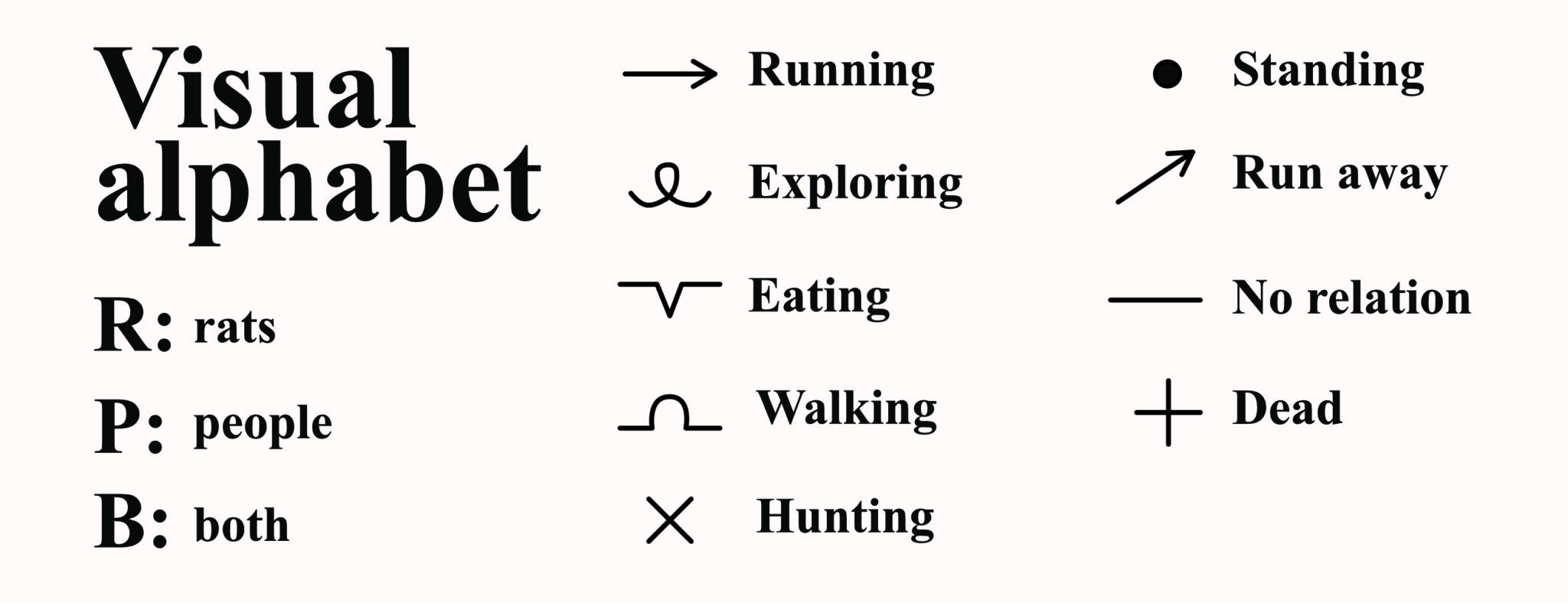
Watching rats in two spots in Medellín represented a methodological challenge that ended with elaborating on a particular note-taking system. This system proposed a set of symbols to speed up data collection since rats were many, fast, and elusive. Although it meaned a small effort to memorize the characters in the beginning, the fieldnote process went really smoothly once it happened.
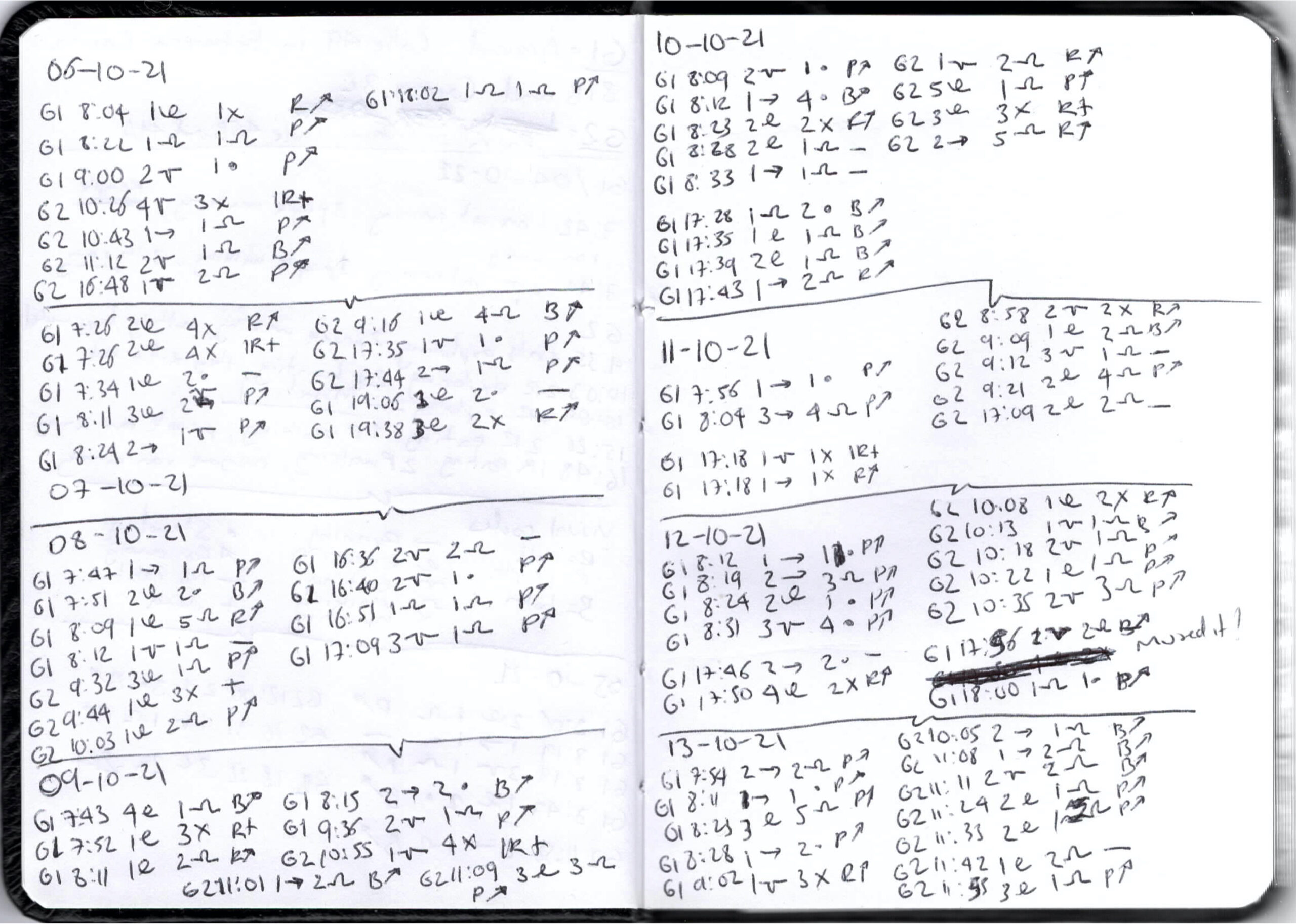
Online references
[1] Franklyn, A. (2016). The more-than-human city. The Sociological review 0(0) 1–17. DOI: 10.1111/1467-954X.12396
[2] Arcari, P., Probyn-Rapsey, F. and Singer, F. (2020). Where species don’t meet: Invisibilized animals, urban nature and city limits. Nature and Space 0(0). 1-26. DOI: 10.1177/2514848620939870.
[3] Hovorka, A. (2018). Animal geographies III: Species relations of power. Progress in Human Geography 1–9. DOI: 10.1177/0309132518775837.
[4] Lynteris, C. (ed.) (2019). Framing Animals as Epidemic Villains: Histories of Non-Human Disease Vectors. Palgrave.
[5] Fisell, M. (1999). Imagining Vermin in Early Modern England. History Workshop Journal 47, p. 1.
[6] ibid p. 2.
[7] Cole, L, (2016). Imperfect Creatures: Vermin, Literature, and the Sciences of Life, 1600-1740. University of Michigan Press. p. 2.
[8] ibid.
[9] ibid.
[10] Edelman, B. (2002). ‘Rats Are People, Too!’ Rat-Human Relations Re-Rated. Anthropology Today 18(3) p. 2.
Handbook references
Medellín
[1] Fisell, M. (1999). Imagining Vermin in Early Modern England. History Workshop Journal 47.
[2] de Bondt, H. and Jaffe, R. (2022) Rats and Sewers: Urban Modernity Beyond the Human. Roadsides, 8, 65-71. https://doi.org/10.26034/roadsides-202200810
[3] Star, SL. (1999). The Ethnography of Infrastructure. American Behavioral Scientist, 43(3), 377-391. https://doi.org/10.1177/00027649921955326.
[4] Larkin, B. (2013). The Politics and Poetics of Infrastructure. Annual Review of Anthropology 42(1), 327-343
New York City
[1] Steele, W., Wiesel, I., & Maller, C. (2019). More-than-human cities: Where the wild things are. Geoforum, 106, 411–415. https://doi.org/10.1016/j.geoforum.2019.04.007.
[2] Shingne, M. C. (2022). The more-than-human right to the city: A multispecies reevaluation. Journal of Urban Affairs, 44(2), 137–155. https://doi.org/10.1080/07352166.2020.1734014.
[3] Narayanan, Y. (2017). Street dogs at the intersection of colonialism and informality: ‘Subaltern animism’ as a posthuman critique of Indian cities. Environment and Planning D: Society and Space, 35(3), 475–494. https://doi.org/10.1177/0263775816672860.
[4] Barua, M. (2021). Infrastructure and non-human life: A wider ontology. Progress in Human Geography, 45(6), 1467–1489. https://doi.org/10.1177/0309132521991220.
[5] McLuhan, M. (2008). The Gutenberg galaxy: The making of typographic man. University. of Toronto Press.

